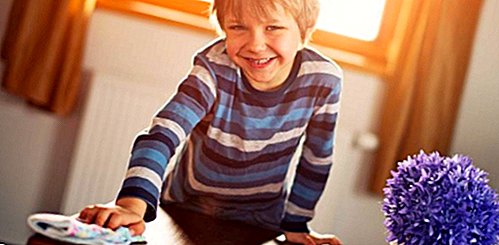Konmari for children: How to educate small order fanatics

If a clairvoyant had told me ten years ago that my children would be very neat, then I would have reported this clairvoyant for fraud. Nevertheless, it happened somehow. My children are cleanup heroes. How did I do that? Here are my 10 wisdoms. Call me the Marie Kondo for children. Buy all the books I'll write about in 10 years. And listen to my wisdom. Even if it happened accidentally ...
1. Clean up yourself
The good thing about it, if you yourself are not a very decent person: You are not tempted to take it from the children. So the little ones notice very early that they are responsible for their own shit. It took us a few years to get there. But when it does happen, that's a big WOW effect. When I enter my children's nursery, I am a visitor and respect their rules. "Mama, on the floor will not cut!", My 6-year-old has recently told me. "Then the snippets slip under the carpet and that's difficult to get out of there." Listen and be amazed. She would never have noticed that if I had picked up the pieces for her.
2. Cleaning up is great fun
"Every work is fun," Mary Poppins taught us. Even the big clean-up lady Marie Kondo sees in it the secret. In her Netflix series, she was asked by a father how she tidied up her two small children. "Not at all, you see, I enjoy it, so they do it on their own," she told him. I believe her. I do not enjoy cleaning up, but I do everything I can to make it as nice as possible. I play loud music and dance like crazy through the house, putting everything in its place. When children do not associate tidying up with pressure and threats, they simply do not seem to develop a blockage against it.
3. Only those who know disorder, learn to love order
Maybe the "We're cleaning up every night" method works as well. But I'm afraid that this will no longer be the case for teenagers at the latest, without lying in Dauerclinch. In our home disorder is expressly allowed. For how should my children understand that order makes everything more beautiful if they know no disorder? If a four-year-old desperately wants to clean up because he no longer finds his favorite toys in the chaos, that makes more sense than a learned lesson without experience.
4. Crates, boxes, boxes
A basic lesson from Marie Kondo: Everything needs a permanent place and has to be visible. I give my children every shoe box and everything that is otherwise suitable as an order system. Sorting is actually the same thing as playing.
5. Things have a soul. Children know that
Your child can not part with cuddly toys, pictures, toys and garbage? Maybe because kids know that things have a soul. Or why else have we draped forty-three stuffed animals and dolls around us, so that none is sad? Helping my children to say goodbye and to thank the Konmari method. No thing is flying into the trash without us dangling properly for the joy it has given us. So farewell is easier.
6.Egon, the hungry trash can
We have a dustbin that we made a funny face for. This trash is always hungry and likes only painted paper. When Egon is hungry, throwing away is much easier. Naturally beautiful paintings are preserved naturally. Because we have? Naturally ? a place.
7. Children are more social than many adults
The sorting is easy for my children, because they know: Others are not as good as we are. Especially in social department stores, toys are in high demand. Since I've explained to my children that parents who do not have that much money can buy cheap birthday gifts for their little ones in these department stores, for example, they are eager to donate discarded things. Again and again, we are happy with the feeling of giving away all the toys out of which they have grown out. This is less stressful and prettier than a flea market and not only teaches the art of smuggling, but also the art of letting go and giving.
8. Less is more
Again and again we put whole toy categories (for example the Duplo, the Playmobilhaus or the Lego railroad in a cupboard in our study.) If we exchange after a few weeks, things are rediscovered with completely new eyes much easier than when the whole room is complete.
9. Your room, your responsibility
Anyone who bluffs loses.If you just pretend that you leave the responsibility for the nursery to the children, you have no chance against rebellion. It was not until I REALLY let go that the children took command. This includes that one offers help and advice, but also a "no thanks" accepted. Or as the little prince puts it, "I have to have two or three caterpillars endure, if I want to get to know the butterflies. "
10. Enjoy the beauty of imperfection together
For all orderliness: I do not want to educate children who always see a TO DO, if not everything is perfect. I do not want to admonish them to clean up in the middle of the game before picking out a new toy. Creativity means bringing things together that do not belong together. And if you have to build a ceiling pillow cave for the dinosaur, who likes to go with the Legozug to his girlfriend, the doll, for the bed to quickly make a doorknob, then that's just the way. For some reason, my children want to clean up later. The emphasis is on later. And that's just as well.










